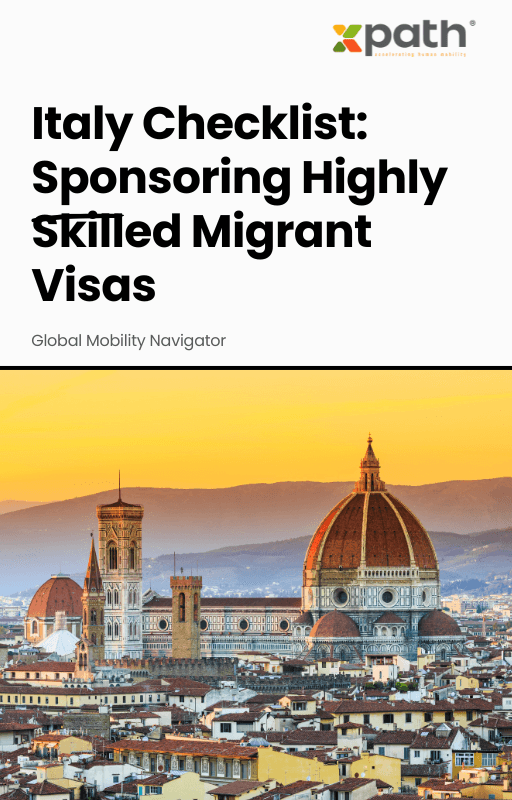Italy Checklist: Sponsoring Highly Skilled Migrant Visas
Grab a copy of a guide to international employee relocation
View E-bookPicture this: You’ve identified the perfect employee for a project in your company’s New York office. The business case is clear, and the excitement is contagious. But U.S. assignments aren’t just a stamp in a passport. They involve a maze of legal, tax, and regulatory hurdles that can turn an exciting opportunity into a compliance nightmare if not properly managed.
The U.S. is famous for its complex tax system and strict immigration rules. Failure to navigate these waters can leave your employee exposed to double taxation, fines, visa denials, and even deportation. On top of that, the IRS and U.S. Citizenship and Immigration Services (USCIS) have ramped up audits and enforcement in recent years, increasing the pressure on companies to get it right the first time.
Let’s start with taxes—often the biggest source of headaches. The United States taxes on a worldwide basis. This means your assignee will be liable for U.S. taxes on income earned both within and outside the country, even if they’re just in the U.S. temporarily. According to PwC’s 2023 Global Mobility survey, 74% of companies cite tax compliance as their top concern for U.S. assignments.
Double taxation is a real risk, but tax treaties between the U.S. and many other countries can provide relief. For instance, the U.S.–UK Income Tax Treaty can help prevent the same income from being taxed in both jurisdictions. The challenge? These treaties are riddled with exceptions and require precise documentation.
Social security is another critical factor. The U.S. has totalization agreements with 30+ countries to prevent dual contributions, but not all countries are covered. Missteps in reporting can lead to penalties for the employer and the employee.
Here’s where a global mobility solution like xpath.global shines. By providing an integrated, digital tax compliance workflow with real-time alerts and document management, HR teams can stay ahead of deadlines, minimize errors, and keep both payroll and employees happy.
Securing visas for the U.S. is no small feat. The country’s immigration system is notoriously strict and constantly evolving. Whether it’s an L-1, H-1B, or E-2 visa, each category has unique qualifications, quota caps, and documentation requirements. The American Immigration Lawyers Association reported a 20% increase in Requests for Evidence (RFEs) for employment-based visas in 2023 alone.
Timing is everything. Visa processing delays in 2024 have averaged four to six months in some U.S. embassies. Any misstep in application, compliance checks, or document submission can push timelines back, risking project delivery and employee morale.
Having a digital platform—like xpath.global—that syncs compliance tasks, paperwork, and stakeholder updates in real time keeps everyone informed and reduces costly errors. It’s like having a GPS for your immigration process.
Consider the case of a fast-growing biotech firm expanding to Boston. Initially, they relied solely on spreadsheets and email to manage four outbound assignments. Things soon got messy: missed deadlines, duplicated efforts, and a near-miss with a visa expiration. After integrating xpath.global into their workflow, the HR team reduced administrative hours by 35%, achieved 100% on-time visa compliance, and received glowing feedback from assignees about smooth onboarding and support. The lesson? Modern mobility solutions aren’t a luxury—they’re a lifeline.
So what are the tripwires? The sheer complexity of tax and immigration law means one-size-fits-all checklists don’t cut it. Each employee is unique, from family situations to compensation structures. Keeping up with changing regulations—the U.S. IRS issued 2,000+ updates in 2023 alone!—feels like chasing a moving target.
Companies also wrestle with data security concerns and the need for seamless communication across time zones and teams. That’s why platforms offering automation, compliance tracking, and robust data privacy (like xpath.global) are quickly becoming industry standards.
Assigning employees to the U.S. is challenging—but with the right preparation and modern tools, it becomes a manageable (even rewarding) process. Building strong partnerships with global tax and immigration experts, educating your assignees and managers, and leveraging technology to automate compliance are now must-haves, not nice-to-haves.
Ready to streamline your employee relocations, slash risks, and make U.S. assignments a cornerstone of your global strategy? Equip your team with a holistic solution designed for today’s world.
1. Do all foreign assignees pay U.S. income tax?
Most assignees working in the U.S. will be subject to U.S. income tax on worldwide income, but tax treaties and assignment length may impact tax obligations. Always consult with an expert for specifics.
2. What’s the best way to avoid double taxation?
Reviewing applicable tax treaties and utilizing tax equalization policies can help. Many global mobility solutions like xpath.global integrate treaty analysis to support compliance.
3. Can families relocate with employees?
Yes. Most work visas allow dependent family members to accompany the primary applicant, but requirements and permitted activities (like employment or study) vary by visa type.
4. How long does the visa process take?
Processing times vary by visa category and country. L-1 and H-1B visas can take several months. Starting early and using digital workflow tools can limit delays.
5. What digital tools can help manage U.S. assignments?
Integrated mobility platforms like xpath.global offer centralized dashboards, compliance automation, and document storage, making assignments faster and more compliant.
Ready to transform your mobility program? Explore xpath.global’s solutions.

Italy Checklist: Sponsoring Highly Skilled Migrant Visas
Grab a copy of a guide to international employee relocation
View E-book